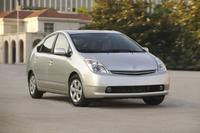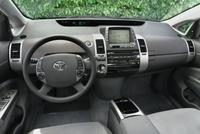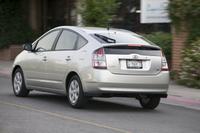2004 New Car Review: Toyota Prius
DRIVING DOWN THE ROAD WITH CAREY RUSS
2004 Toyota
Prius
How to best describe the 2004 Toyota Prius?
How about ``more'' and ``better.'' As in more interior space, better looks, more power, and better driveability. Toyota is determined to make the gasoline-electric hybrid car a choice of the mainstream buyer, not just a statement by technophiles and environmentalists, and the new Prius is merely the first step in that plan. Look for more Toyota hybrids in the future - and some from Lexus as well.
Prius drivers need make no sacrifice to comfort or convenience. The Prius redefines ``economy car.'' Forget about roll-up windows and roasting on a hot day. Power windows and mirrors, air conditioning, cruise control, and a high-grade AM/FM/CD stereo system are standard equipment. Optional is a ``Smart Entry and Start'' system that is similar to those found in some high-end luxury cars, but with a couple of unique Prius twists.
Here's the drill: Put the small ``key'' fob device in your pocket. Walk up to the car, pull on the door handle. It unlocks. Get in. Now for the boot-up procedure. With your foot on the brake pedal, press the ``Power'' button - no key, your computer doesn't have a key, right? - then unlock the parking brake by pressing the ``P'' button to the right of the steering wheel. Then move the small joystick-like shift lever below that to ``forward'' or ``reverse'' and you're on your way. The shutdown procedure is the reverse of that. Stop the car, with your foot on the brake. Press ``P'', then the ``Power'' button, get out of the car, press the black button on the door handle (or the remote fob) and it locks.
The `04 Prius's chassis platform is new, as is the electric motor and control system. The gasoline engine is basically the same 1.5-liter unit as before, but revisions give it a little more horsepower, 76, than the previous 70. The new, higher-voltage electric motor makes significantly more power and torque, with 67.5 horsepower between 1,200 and 1,500 rpm. Electric motors produce maximum torque right from a standstill, making them perfect for quick lunges into traffic. And with 295 lb-ft between 0 and 1,200 rpm - far more than a Camry's V6 - low-speed acceleration is never a problem. The ``Hybrid Synergy Drive'' control system determines how much driving power comes from each source, and does so with no input from the driver. Driving a Prius is no different from driving a small car with an automatic transmission. The engine and regenerative braking are used to charge the battery pack, just fill the 11.9-gallon gas tank every four or five hundred miles. I'm at the end of a fascinating week with a fully-equipped new Prius as I write. I will admit to not making the most efficient use of Toyota's high-tech wonder, as most of my driving was on the highway. And much of that was crossing a steep range of mountains. So my personal mileage was a ``mere'' 45. But then, a regular mid-sized four-cylinder sedan would have been hard-pressed to break 30 in the same conditions, and city driving saw over 60 mpg often indicated on the energy-use display. And all driving was done in comfort with all of the amenities expected not merely in a mid-sized sedan, but in a mid-sized near-luxury sedan. (Well, OK, no leather, but no big deal there.) No compromises and no sacrifices.
APPEARANCE: What could be better for a futuristic-technology car than a futuristic look? And the 2004 Prius looks like it came from 20 years in the future, but without a forced sci-fi movie prop look. Toyota calls it ''monoform,'' and that seems appropriate. Since it's aerodynamically-curved, it can't be ``one-box.'' So ``one curve'' it is. It's larger than the 2000-2003 model, with a six-increase in wheelbase, five inches in length, an inch in width, and a half-inch in height, but it's still very compact for its cabin capacity. A small window in the rear panel increases rearward visibility, and the alloy wheels have plastic rim protectors against curb damage, a thoughtful feature.
COMFORT: The ``monoform'' body style benefits passengers with noticeably more interior space and cargo capacity. Shoulder and leg room increase the most, and there is almost as much trunk space as in a Camry. The Prius is now considered a mid-sized car. In appointment it's at least the equal to an upper-midlevel Camry, but with a unique design. High-quality synthetic materials used in its interior, and front seat comfort is very good. The base of the well-raked windshield is far away, but dark, textured material on the top of the instrument panel keeps glare at bay. The main instrument display is at the base of the windshield, for easier eye focusing, and all important information is easily visible. Audio, climate, information, and navigation (if fitted) systems are controlled through a LCD screen at the top of the center stack. This also displays the amusing and informative energy-use diagram. Front storage is very good, with large door pockets, a double-decker glove box, and a large console box. The rear seat is notable for head- and leg-room, and folds 60/40 for cargo. A shade covers the cargo area, and there is hidden storage for small items under the floor.
SAFETY: The Prius's chassis has front and rear crumple zones, side-impact door beams, and front airbags. Front side and curtain airbags are available.
ROADABILITY: In ride and handling the Prius seems little different from a Camry or Corolla. The MacPherson strut front, torsion-beam rear suspension provides a comfortable, well-damped ride, and the electrically-assisted rack-and-pinion steering has a light but connected touch. Stability at speed on the highway is good, even in strong winds, and the clean aerodynamics also contribute to low wind noise levels.
PERFORMANCE: Get in, boot up, and drive. On the road, differences between the Prius and any regular car are minimal. It drives and feels like a small-displacement car with an automatic transmission optimized for economy, and, unlike the first-generation Prius, has no problem getting up steep highway hills at speed. The engine will be a little noisy, and sound like it's got an automatic that is ``hunting'' for the correct gear, but progress is steady. On the highway, the Prius operates primarily from the 1.5-liter, 72-horsepower gasoline engine. Around town, the Hybrid Synergy Drive gives preference to the electric motor under about 25 mph, with extreme smoothness and quiet the result. Not to mention good acceleration - the motor makes 295 lb-ft of torque from 0 to 1,200 rpm - and maximum gas mileage. The gas engine will sometimes come on to help, as does the motor at higher speeds. The process is very smooth and civilized. Maximum combined horsepower is up to 106 from the previous 98, and that is noticeable. Despite the power increase, fuel economy is up from the previous EPA 52 city, 45 highway to 60 / 51. The least-publicized, but to me best feature of hybrid vehicles is regenerative braking. When decelerating or descending a hill, the engine switches off and the motor acts as a generator, recharging the 200-volt NiMH battery pack. Magnetic drag from the generator operation slows the car in much the same way as compression braking in a gas or diesel engine. Put the shift lever in ``B'' for extra braking. The Prius's mechanical brakes are nothing unusual, a regular front disc, rear-drum system with four-wheel antilock, but add regenerative braking and watch stopping power increase amazingly.
CONCLUSIONS: The 2004 Toyota Prius shows that hybrid technology is ready for prime time.
SPECIFICATIONSbr> 2004 Toyota Prius
Base Price $ 19,995
Price As Tested $ 26,202
Engine
Type Dual overhead cam 16-valve inline 4- cylinder with VVT-i
variable valve timing
Engine Size 1.5 liters / 91 cu.
in.
Horsepower 76 @ 5000 rpm
Torque (lb-ft) 82 @ 4200
rpm
Electric motor 500-volt permanent magnet
synchronous
Horsepower 50 kW (67.5 hp) 1200-1500 rpm
Torque (lb-ft) 295 @ 0-1200 rpm
Battery pack 168 1.2v NiMH
cells (201.6 volts)
Transmission electronic
continuously-variable
Estimated total system horsepower
106
Wheelbase / Length 106.3 in. / 175.0 in.
Curb
Weight 2890 lbs.
Pounds Per Horsepower 27.3
Fuel
Capacity 11.9 gal.
Fuel Requirement 87 octane unleaded
regular gasoline
Tires P185/65 SR16 m+s Goodyear Integrity
Brakes, front/rear vented disc / drum, plus regenerative
braking. Antilock standard
Suspension, front/rear
independent MacPherson strut / semi-independent torsion beam
axle
Drivetrain front engine and motor, front-wheel
drive
PERFORMANCE
EPA Fuel Economy - miles per gallon city
/ highway / observed 60 / 51 / 45
0 to 60 mph est. 10
sec
Coefficient of Drag (cd) 0.26
OPTIONS AND CHARGES
Package #9 - includes:
intermittent rear wiper, driver and passenger side and curtain
airbags, auto-leveling HID headlamps, smart entry and start,
security alarm, Homelink(tm), voice-activated navigation
system, JBL 9-speaker audio system with AM/FM/cass/6-disc CD
changer, vehicle stability control, front foglamps $ 5,245
Carpet floor mats and cargo mat $ 184
Glass breakage sensor
$ 149
Rear bumper applique $ 65
Cargo net $ 49
Destination charge $ 515





